Part of a series of articles titled Reckoning with a Warming Climate.
Article
Responding to the Effects of Climate Change on Subsistence in Alaska
Amy Craver, Cultural Resource Historian, Denali National Park and Preserve, National Park Service
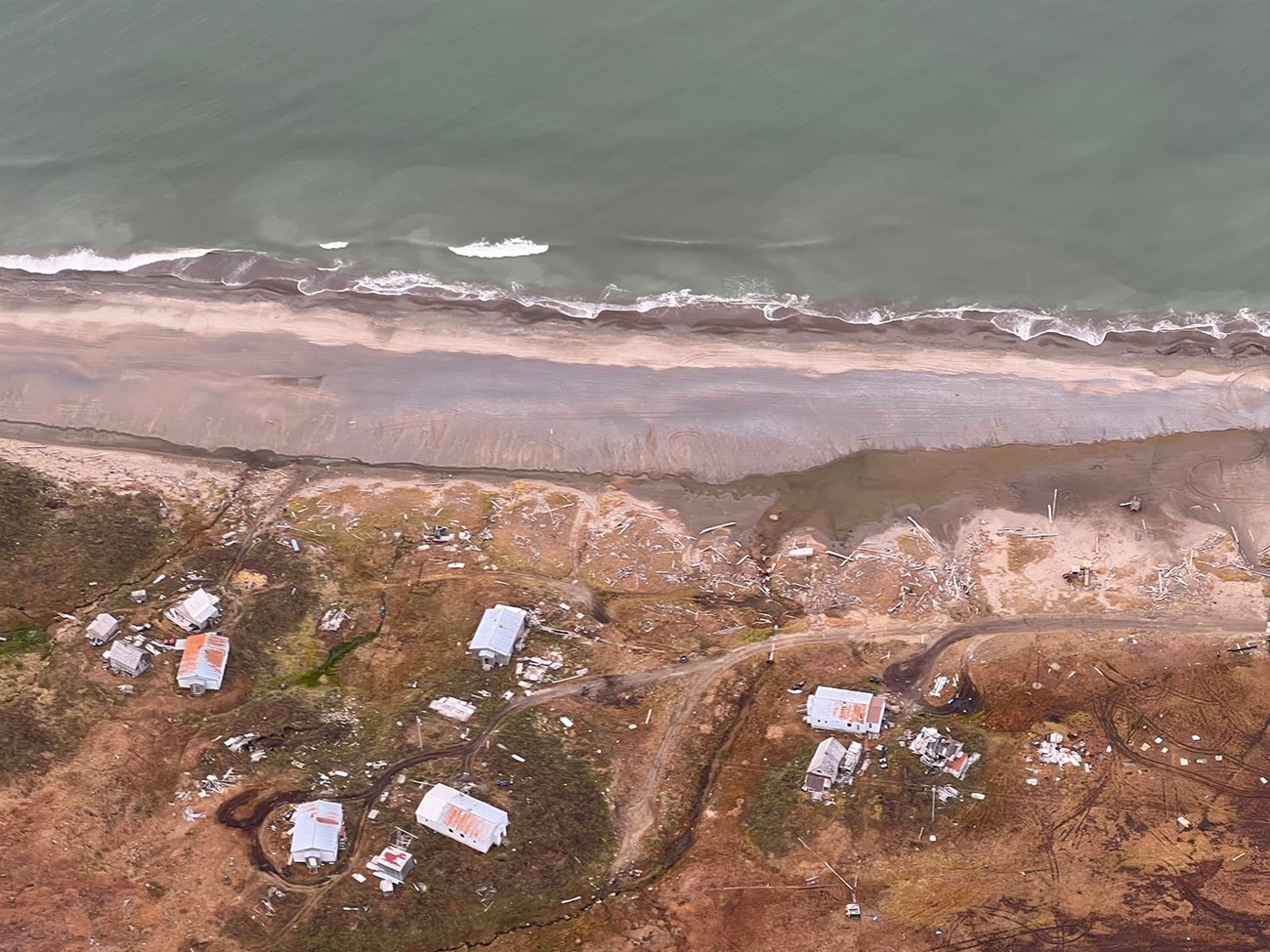
NPS/TAHZAY JONES
A typhoon, smoke from wildfires, and increasing rain are not what most people imagine when thinking of the Arctic, yet these are some of the climate-driven events included in the National Ocean Atmospheric Administration’s 2022 Arctic Report Card. The Report Card, an annual update on the state of the Arctic, shows in detail how climate change is transforming the icy, snowy Arctic into a warmer, wetter environment. It describes how warming air temperatures, shrinking sea ice, shorter periods of snow cover, increased wildfires, rising levels of precipitation, and changes in animal abundance and migration patterns profoundly affect the safety, food security, health, economic wellbeing and cultural traditions of Alaska Natives and other Arctic residents (Druckenmiller et al. 2022).
Although Northern communities have a deep cultural history of adapting to change, they are highly vulnerable to the impact of rapid climate change. In the Alaskan Arctic, the Bering, Chukchi, and Beaufort seas have undergone changes in ocean circulation, currents, water temperatures, and nutrient availability, with serious impacts on fisheries. On land, thawing permafrost impacts roads, which have to be continually rebuilt. With warming temperatures, early breakup and late freeze-up create poor ice conditions, making access to hunting areas for important subsistence species more dangerous (Brown et al. 2018). In some northern communities, ice cellars are melting, making long-term storage of traditional foods more difficult. Winter storm surges, also linked to climate change, erode coastlines, make travel difficult by land or sea, and destroy cabins and camps used for subsistence activities (USDA Northwest Climate Hub 2023).
In Alaska, the word “subsistence” is not just about getting food for nutrition but represents a way of life and a relationship with wild resources. Subsistence foods connect people to their culture and their environment. Harvesting, processing, and eating wild foods contributes to the physical, mental, and spiritual well-being of individuals and communities. For rural Alaskans, including Alaska Natives with cultural and spiritual ties to the land going back millennia, and non-Natives who choose to live a self-sufficient lifestyle far from stores, cash-paying jobs, and the state’s few roads, subsistence is part of what defines them.
Some of the most damaging effects of climate change in Alaska have been the social and cultural impacts for subsistence users. When individuals and families are unable to procure subsistence foods, traditional sharing becomes more difficult. Hunters esteemed for their abilities and willingness to share food may find their roles changing as the landscape changes. Older generations may no longer be able to teach young people about subsistence harvesting and processing. Additionally, as subsistence opportunities decline, it may become cost prohibitive to stay in the village, encouraging residents to relocate to hub villages and Anchorage (Pete 2010). Relocation to urban areas makes it even harder to maintain subsistence activities and networks. Ultimately, relocation to a new village site or to an existing village or regional hub may be the only options as villages disappear or become uninhabitable due to climate change-related erosion or flooding.
This article describes the challenges climate change poses to subsistence harvests, tells some of the ways subsistence users have adapted to change, and suggests how the NPS can support continued subsistence opportunities in Alaska. We focus on parklands from two regions of Alaska: the Northwest, represented by the Western Arctic Parklands and Bering Land Bridge National Preserve; and Interior Alaska, with examples from Denali National Park and Preserve and Wrangell-St. Elias National Park and Preserve.
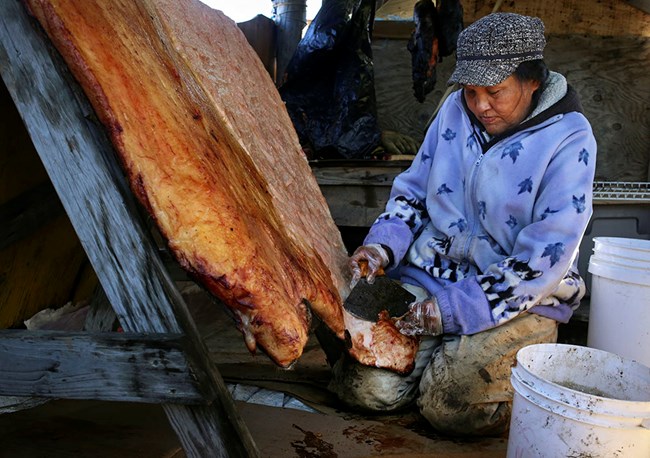
NPS/EMILY MESNER
Northwest Alaska
Subsistence users in Northwest Alaska, many of whom live along the coast and depend on ocean resources, are experiencing many of the accelerated effects of climate change seen throughout the Arctic. A team led by Kristen Green and Anne Beaudreau interviewed subsistence users in the primarily Iñupiat communities of Kotzebue and Kivalina to discover what factors related to climate change were causing stress to subsistence users. The stressors most frequently cited were changes in sea ice, weather, coastal erosion, raised water levels and flooding, changes in snow cover, and degradation of permafrost. These stressors have unique effects on mammal populations, fishing practices, and community infrastructure.
Marine mammals, particularly those whose primary habitat is sea ice, have been among the species most affected by climate change. Ringed seals, for example, depend on stable ice for mothers to nurse their pups. Polar bears now have to swim much further to reach the ice, which is their most productive hunting habitat (Jones 2011). The shrinking sea ice also means a decline in opportunities for subsistence hunters because of lack of habitat and unsafe hunting conditions. Local residents mentioned shifts in harvest seasons for bearded seal and beluga (Green et al. 2021).
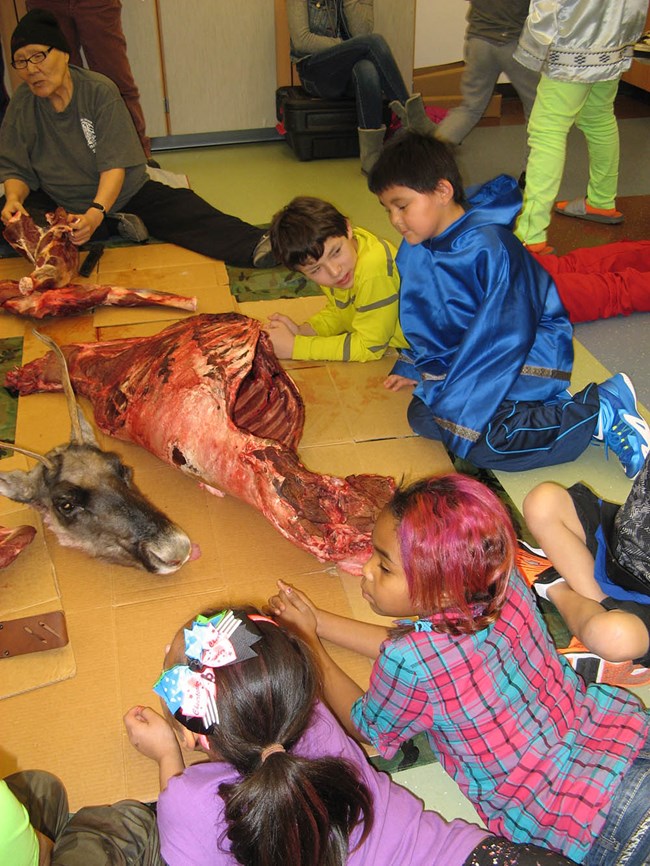
NPS/MARCY OKADA
The behavior of terrestrial mammals has also been affected by climate change. Caribou, a prime subsistence species for many Alaskans, live through the winter on lichens they eat through the snow. Increased precipitation may create icy crusts on the snow, making it harder for caribou to access their food, increasing the chances of winter starvation. On the other hand, warmer temperatures may also lead to earlier plant growth on calving grounds, providing increased nutrition for cows and calves.
Other land mammals have been impacted as well. When it gets too warm in the summer, moose typically seek shelter rather than foraging for nutritious foods needed to keep them healthy. Bears have been noticed coming out of hibernation early or even never hibernating. Beaver are moving north in areas where they were not previously located. A recent study found that from 2002 to 2019, the number of beaver dams grew from two to 98 in an area of less than 40 square miles near Kotzebue (Jones et al. 2020).
The effect of climate change on fish is complicated. Changes in water temperature can be consequential for fish survival (Moerlein et al. 2013). Changing water levels and shallower rivers directly impact fishing; locations that have been reliable in the past are no longer a sure bet and sometimes force people to find new spots to fish. Fishing nets or fish wheels snag on the river bottom or fill more quickly with debris, often sustaining damage in the process. Decreases in salmon runs particularly threaten a key subsistence resource for many Alaska Native communities.
In Northwest Alaska, subsistence harvesters in Noatak, Shungnak, and Selawik have noted that environmental changes are impacting their subsistence fishing practices. Lower water levels are impeding boat access to favorite fishing locations. Unpredictable weather conditions challenge traditional fish drying practices. In all three communities, residents are noticing increasing numbers of beaver moving into fishing areas resulting in dams that block boats from accessing fishing locations and creating lower water levels (Moerlein et al. 2013).
Climate change has also exacerbated the problems of erosion and flooding in rural Alaskan communities. Melting permafrost makes coastlines more prone to erosion, and barrier sea ice is coming later in the year. In Northwest Alaska, storm surges exacerbate normal erosion. Coastal villages, such as Shishmaref and Kivalina, are vulnerable to increasingly violent fall storms. These villages depend heavily on subsistence hunting, especially marine mammals. As a result of severe storms, families in Shishmaref and other coastal communities have lost their winter supplies of walrus, fish, seal, and seal oil.
Melting permafrost and erosion have increased flooding risks and caused the land around homes to erode. Several buildings in Shishmaref have crumbled into the ocean. There has been ongoing discussion of relocation of the whole village, with costs estimated at up to $1 million per household. Subsistence harvests may cost more if the community is moved. Subsistence hunters use more fuel, and their mode of transportation (e.g., boats, snowmachines) wears out faster, when they have to travel further to harvest resources. In addition to the monetary cost, relocation would cause considerable disruption to community life. If residents of a coastal community are moved further inland, they may lack knowledge of or traditional access to hunting areas near their new village. Sharing networks that households and families enjoyed in their home communities may be stressed or cease to function altogether. Relocating village residents to hub communities or urban areas would make it even harder and costlier to maintain subsistence activities and social networks. Many residents of threatened communities are aware of the possible consequences of moving and seek to avoid them in advance in the selection of relocation sites.
Interior Alaska
Communities in Interior Alaska face many of the same climate change-related problems as those on the coast. However, because of the need to travel long distances in the Interior, transportation is a special priority. People traveling across Interior Alaska are encountering climate-related changes in the environment that are challenging their traditional access to important local resources, which makes subsistence hunting costlier and riskier. New challenges include increased uncertainty about how to best prepare for seasonal changes, dangerous physical trail conditions, and unprecedented negative impacts on community life.
Rivers in Interior Alaska have always provided critical travel corridors for residents in this mostly-roadless region. Travel is usually by boat and four-wheelers in summer, and by snowmachines or dogteam in winter (Brown et al. 2018). For Interior Alaska residents, the Yukon, Tanana, Kuskokwim, and Chandalar rivers are equivalent to major highways around urban areas.
Historically, rivers and lakes have been efficient winter travel routes for snowmachine and dogteam travel (Schneider et al. 2013). Thick, stable, and predictable ice meant safe and reliable winter travel. Increasingly, subsistence users are reporting that rivers and lakes freeze later and thaw earlier than in the past. Thin ice and open water are becoming more common in midwinter, restricting access to usual travel routes and creating extremely dangerous conditions. More frequent occurrences of shelf ice forming along riverbanks can pose obstacles to snowmachine routes all winter long.
During the summer, residents of the Interior traverse large water bodies by boat or, on land, use all-terrain vehicles on limited trails. Increased erosion can make boat travel on rivers more dangerous due to the increased amounts of debris in the water, with river channels becoming shallower and wider. More sediment deposition in rivers can also quickly change well established river channels, increase the size of sandbars, and make some rivers shallower and harder to navigate. Communities located along rivers also face increased risk from flooding.
Some effects of climate change make subsistence resources more accessible. For example, unseasonably high or low water in September—an important time for moose hunting—can either help or hinder hunting. High water on main rivers covers riverbanks where moose might otherwise be found but can also fill small tributaries that improve hunting access. Abnormally low water prevents access to lakes and sloughs near river channels.
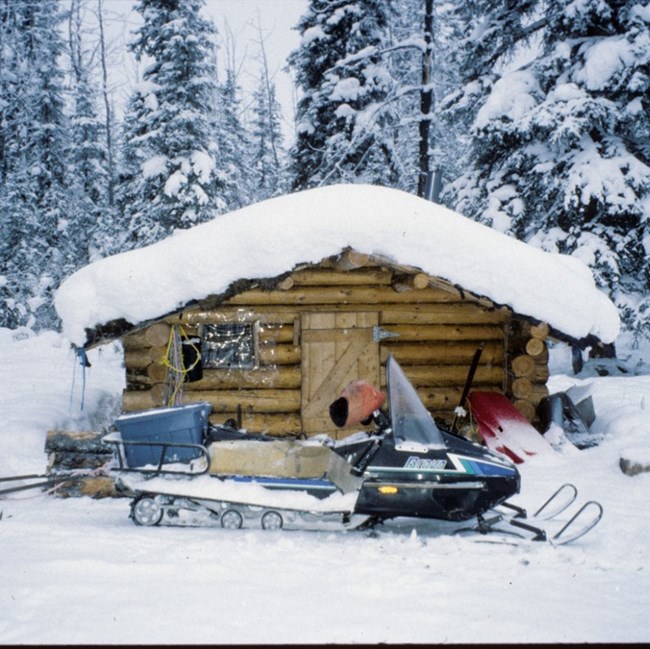
PHOTO COURTESY OF MIKI AND JULIE COLLINS
In the past two decades, Interior Alaska residents have observed changes in river ice that create significant hindrances to travel and subsistence practices. The Wrangell-St. Elias National Park and Preserve Subsistence Resource Commission recently completed a study by the Ahtna Intertribal Research Commission to gather first-hand knowledge from local subsistence users about changing ice and snow conditions in the Copper River Basin. These users reported changes in river ice, snowpack, and wind conditions over time, including later freezeups and earlier breakeups. Some of these users had observed increased difficulty in accessing key subsistence areas since as early as the 1970s (Miller 2023).
Near Denali National Park and Preserve, lifelong Alaskans Miki and Julie Collins from Lake Minchumina acknowledge that subsistence life in the bush always requires flexibility in response to severe weather conditions; however, with climate-related changes, they no longer know what to expect. During a big rainstorm in November of 2010, they were confused and alarmed by conditions that were far outside the normal range for that time of year. When there are early spring breakups they must rush to sled in supplies and fill their woodsheds before the snow melts. They have also observed that due to hot summers they are catching fewer fish.
One of their biggest challenges in responding to environmental change is planning for an unpredictable future. Miki and Julie struggle with questions: Should they rush to finish a new dog sled for trapping even though it has been years since they needed a sled by mid-October? Should they pull their fish net at the first sign of freezing even though in recent years the first ice is generally followed by weeks of warm weather (Collins 2016)?
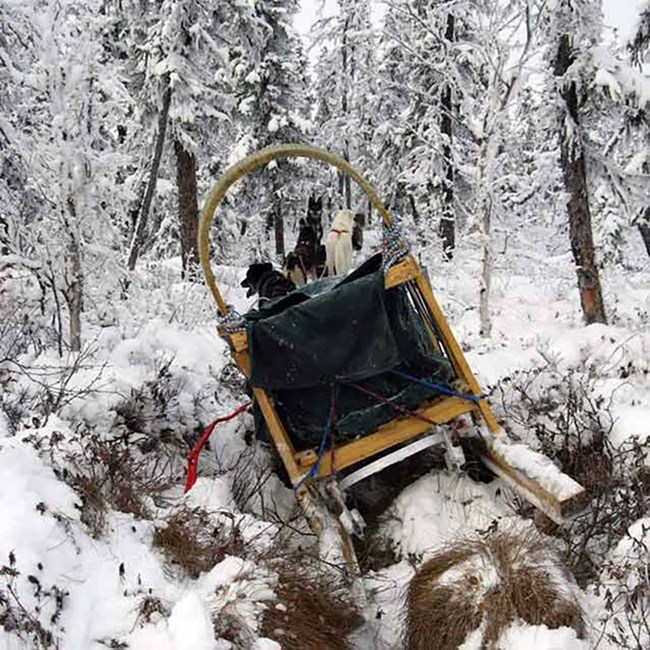
PHOTO COURTESY OF MIKI AND JULIE COLLINS
Trails used for subsistence activities are also impacted by climate change. Trails and roads located close to riverbanks and lakes are increasingly being damaged or completely destroyed by bank erosion. Banks are steeper, making it more difficult to get to portages. Although trails are always important corridors for accessing resources, trail access across lakes and wetlands is limited in summer by the increased presence of water. On land, unseasonably wet conditions quickly deteriorate trails and sometimes make them impassible.
Subsistence users from Cantwell who hunt in the Traditional Use Area of Denali National Park and Preserve reported seeing more sinkholes on their way to their moose hunting camp, which are likely related to thawing permafrost (Mayo, personal communication, 2020). During the fall hunting season, these holes fill with water and sometimes cut off trail access. ATVs and snowmachines get stuck in the sinkholes.
Recently, delayed and more variable seasonal snow accumulation, as well as rain precipitation during winter, are making winter travel harder and unpredictable (Cold et al. 2020). Rain-on-snow icing events (such as one during the winter of 2021/2022 at Denali) are more common and leave the snowpack crusty, thin, and hard. Trails are much rougher and are hard on sled suspensions and dogs’ feet. It is much easier to get stuck on brush and overheat snowmachines that need a deep, soft snowpack to cool engines. With these changing conditions, there is more use of four-wheelers during the winter season.
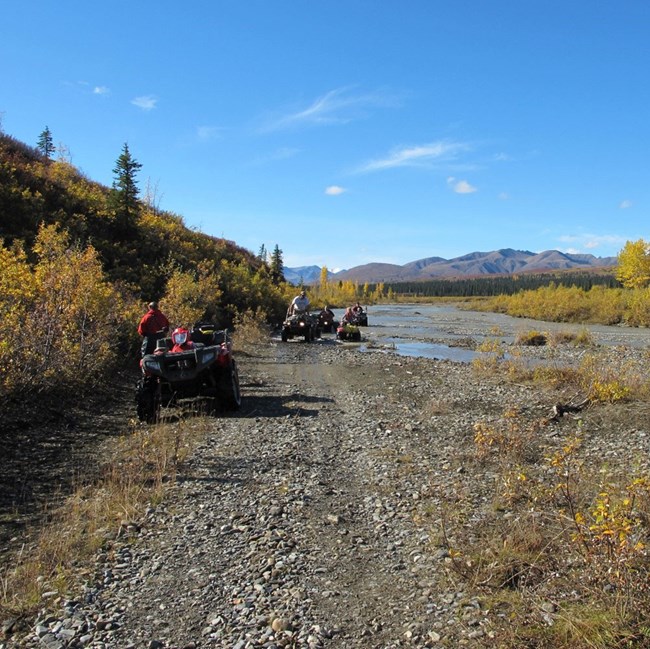
NPS/AMY CRAVER
Environmental changes also impact people as they traverse the landscape. Travel is more dangerous in conditions such as open water during winter, or debris-filled rivers during summer. The changes in the landscape are hard on equipment, causing boat motors to clog more often or ATVs to break down. In some cases, access can improve; for example, high water levels in fall have allowed travel up small streams that may have previously been unnavigable (Green et al. 2021).
Some hunting, fishing, trapping, and gathering opportunities are reduced or even missed, with increased variability in seasonal weather and physical events such as the timing of fall freeze-up and spring break-up. River ice deteriorates faster in the spring, increasing the length of the period when river travel by snowmachine is unsafe yet boating is still impossible (Brown et al. 2018). Higher precipitation levels and warm temperatures during a time of year that was previously dry and cool affects fall hunting opportunities. All these environmental changes have made for more uncertain travel conditions throughout the year.
In addition to its effect on travel and subsistence harvests, climate change has many other impacts on community life. Researchers led by the Tanana Chiefs Conference conducted a study to document Traditional Ecological Knowledge (TEK) on climate change observations from the Koyukon Athabascan people of Allakaket and the Iñupiaq people of Alatna. Both communities reside near the Gates of the Arctic National Park and Preserve. The study included observations of species and habitat change as well as traditional stories associated with climate change.
Like many Native peoples across Alaska and the Arctic, the residents of Alatna and Allakaket are noticing changes in temperatures while the seasonal patterns are far less predictable than in the past. Community members consistently mentioned that freeze-up is getting later. They also noted that springtime is arriving earlier and it is getting warmer faster. This change is not just significant to subsistence activities but also to the social life of both communities. Alatna, located across the Koyukuk River from Allakaket, does not have a school, store, health clinic, gas station or airport, so it impacts the entire community when the river is not suitable for travel during freeze up and break up. When the Koyukuk River freezes up two weeks later than usual, the children from Alatna cannot attend the school located in Allakaket. The ice instability has a direct impact on school attendance (Watson 2018).
Community Strategies for Resilience
Traditionally, communities and families respond to ordinary fluctuations in subsistence foods through harvesting flexibility and increased sharing. Alaska Natives and rural residents share subsistence resources, labor, equipment, and cash within and between extended families. Sharing resources through extensive social networks limits vulnerability to food shortages. It is traditional to share labor in harvesting and processing as well. Also, when one resource becomes unavailable or inaccessible, harvesting more of another resource makes up the shortfall. One traditional strategy to combat fluctuating resources is to harvest multiple species and trade any excess harvest to other communities. Coastal communities have often traded marine mammal products in exchange for land mammal products from inland. Climate change can especially impact cooperation if several preferred subsistence resources are at risk at the same time. Sharing, trading, and cooperation may pose new challenges if people need to move to new subsistence areas or need to disperse farther to harvest foods. In the face of individual and community relocation, and of increased difficulty in procuring traditional foods, these networks will need to become more complex and stretch over wider distances (Callaway 2013).
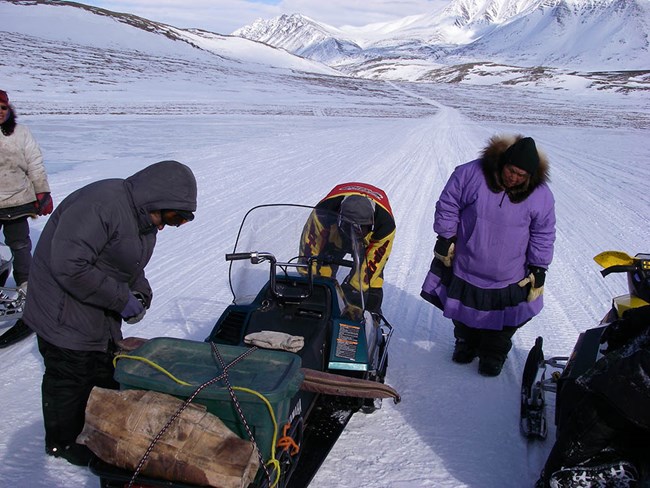
Subsistence users from Kotzebue and Kivalina identified some of the strategies they might employ if harvesting animals became more challenging due to environmental changes and unpredictable conditions. One strategy was to use different or multiple means of transportation (boat, ATV, or snowmachines) to hunt on land or sea ice, or to travel to subsistence camps (Green et al. 2021). When hunters have to travel further, they need bigger and more expensive boats and motors, and they need to pay more for fuel. Wealthier families are thus able to gain greater access (Godduhn et al. 2014). In Kotzebue, some subsistence users reported using the internet and social media to find locations and abundance of animals. They also mentioned the need to shift to hunting new species, which would necessitate time to acquire knowledge about how to harvest new plants and animals. Increased sharing and cooperation, however, could mediate climate change-caused stress on subsistence activities (Green et. al. 2021).
Subsistence users from the Denali region suggested changes in Park management to account for environmental changes by shifting hunting regulations based on current seasonal weather conditions, reestablishment of traditional practices such as sheep hunts and changes to regulations to allow younger family members to hunt for elders (Knapp et al. 2014). In addition, to promote traditional mentorship, the NPS can support culture camps and school programs to ensure that opportunities continue for intergenerational transmission of knowledge, and so that people of all ages can learn about changes to the environment.
In other parks, staff are working with Subsistence Resource Commissions to develop wildlife regulatory proposals to respond to impacts of climate change on resource populations, habitat, and harvest seasons. In the Alaska region, the NPS Subsistence Advisory Committee has been systematically funding subsistence harvest projects where there are information gaps or urgent concerns. The data gathered in these projects may be compared to past or future years to document changes in harvest levels, use areas, and sharing.
Corrie Knapp’s dissertation research at Denali National Park and Preserve explored how climate change challenges conservation strategies of protected areas. Knapp interviewed long term Denali National Park and Preserve staff, scientists, subsistence community users, bus drivers, and business owners to assess what types of observations can contribute to adaptation planning for climate change that will positively impact both ecological resources and local subsistence users. The study demonstrates that observations of users on the ground can provide important information to understanding climate change and should be included with other stakeholders’ engagement and adaption planning for conservation areas. With increased participation by stakeholders in climate adaptation planning, managers can make better informed decisions (Knapp et al. 2014).
Future NPS projects are needed in order to mitigate the impacts of climate change on subsistence uses and develop climate change adaptation strategies. The agency can collaborate with tribes and local communities to develop awareness, education, and knowledge about climate change. For example, establishing a central online database of local subsistence topics, such as where berries grow, when and where ice develops, and the thickness of seal blubber and caribou fat could help develop the bigger picture of regional and systemic change. The NPS can work with schools and other agencies to increase education about climate change, highlighting concrete examples of climate change that could motivate subsistence users and others to change their behaviors toward the environment. As part of the Federal Subsistence Management program, the NPS should support changes to regulations that mitigate the impacts of climate change, such as establishing proxy hunts, reestablishing traditional practices that promote wider distribution of harvests, and integrating local observations and knowledge more effectively in decision making.
The effects of climate change have already greatly impacted the lives of subsistence users in Alaska. Documenting environmental changes, and identifying the directions of change, can help rural subsistence users, as well as federal and state managers, prepare for the challenges of the future.
References
Brown, D., T. Brinkman, D. Verbyla, C. Brown, H. Cold, and T. Hollingsworth. 2018.
Changing river ice seasonality and impacts on Interior Alaskan communities. Weather, Climate, and Society 10(4): 625-640.
Callaway, D. S. 2013.
The long-term threats from climate change to rural Alaskan communities. Alaska Park Science 12(2): 86-91.
Collins, J. 2016.
When Snow Becomes Rain and Other Impacts of Warming Weather on Subsistence Life in Alaska. Available at: https://www.nps.gov/dena/getinvolved/dca_collins.htm (accessed July 20, 2023)
Cold, H. S. T. J. Brinkman, C. L. Brown, T. N. Hollingsworth, D. R. N. Brown, and K. M. Heeringa. 2020.
Assessing vulnerability of subsistence travel to effects of environmental change in Interior Alaska. Ecology and Society 25(1): 20.
Druckenmiller, M. L., R. Thoman, and T. A. Moon. 2022.
Arctic Report Card 2022: Executive Summary 2022. NOAA Technical Report OAR ARC 22-01. 2022.
Godduhn, A. R., N. M. Braem, and M. L. Kostick. 2014.
Subsistence Wildlife Harvests in Kotzebue, Alaska, 2012-2013. Alaska Department of Fish and Game, Division of Subsistence, Juneau, Alaska, USA.
Green, K. M., A. H. Beaudreau, M. K. Lukin, and L. B. Crowder. 2021.
Climate change stressors and social-ecological factors mediating access to subsistence resources in Arctic Alaska. Ecology and Society 26(4): 15.
Green, K. M., S. S. Fletcher, A. H. Beaudreau, and S. M. Whiting. 2020.
Iñupiaq values in subsistence harvesting: Applying the community voice method in Northwest Alaska. Society & Natural Resources 33: 122-137.
Herz, N. October 29, 2019.
No Bowhead Sightings Yet For Alaskan Whalers. Some Blame Climate Change. Alaska Public Radio. Available at: https://www.npr.org/2019/10/29/774177054/no-bowhead-sightings-yet-for-alaskan-whalers-some-blame-climate-change (accessed July 20, 2023)
Jones, B. M., K. D. Tape, J. A. Clark, I. Nitze, G. Grosse, and J. Disbrow. 2020.
Increase in beaver dams controls surface water and thermokarst dynamics in an Arctic tundra region, Baldwin Peninsula, northwest Alaska. Environmental Research Letters 15(7): 075005.
Jones, N. 2011.
The polar bear struggle. Nature Climate Change 1: 433.
Knapp, C. N., F. S. Chapin III, G. P. Kofinas, N. Fresco, C. Carothers, and A. Craver. 2014.
Parks, people, and change: The importance of multistakeholder engagement in adaptation planning for conserved areas. Ecology and Society 19(4): 15pp.
Miller, O. 2023.
Winter travel, access, and changing snow and ice conditions in Alaska’s Copper River Basin. Natural Resource Report. NPS/WRST/NRR—2023/2508. National Park Service. Fort Collins, Colorado.
Moerlein, K., C. Carothers, and J. A. Lopez. 2013.
Observations of Changing Conditions in Northwest Alaska and Impacts on Subsistence Practices. Alaska Park Science 12(2): 58-63.
Pete, M. 2010.
Written testimony for field hearing on “The Changing Arctic: Implications for Federal Resources and Local Communities” before the Senate committee on commerce, science, and transportation. Available at: Senate Hearing, 111TH Congress - The Changing Arctic: Implications For Federal Resources and Local Communities | PDF | Exclusive Economic Zone | Northwest Passage (scribd.com) (accessed July 20, 2023)
Schneider, D. P., C. Deser, J. Fasullo, and K. E. Trenberth. 2013.
Climate data guide spurs discovery and understanding. Eos 94(13): 121-130.
U.S. Department of Agriculture Northwest Climate Hub. 2023.
A storm is brewing: Climate change and coastal storms in western Alaska. Available at: https://www.climatehubs.usda.gov/hubs/northwest/topic/storm-brewing-climate-change-and-coastal-storms-western-alaska (accessed July 20, 2023)
Watson, A. 2018.
Ethnographic Overview and Assessment of Gates of the Arctic National Park and Preserve: Subsistence Land Use of the Kobuk Preserve. National Park Service, Alaska Region.
Last updated: September 6, 2023
